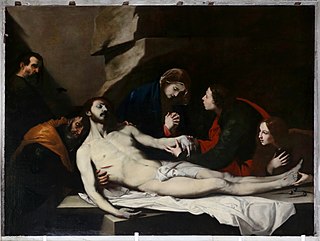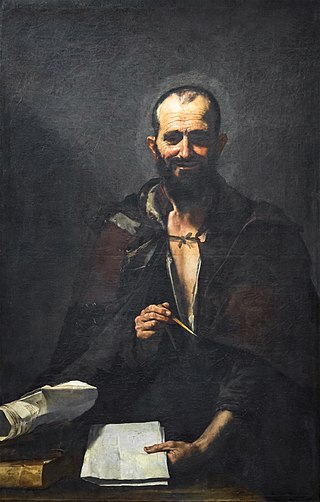
Saint Sebastian is a 1636 oil on canvas painting by Jusepe de Ribera. Its composition was later reprised for a work now in Naples. [1] It was first recorded in the Spanish royal collection in 1747 and it is now in the Museo del Prado in Madrid. [2]

Saint Sebastian is a 1636 oil on canvas painting by Jusepe de Ribera. Its composition was later reprised for a work now in Naples. [1] It was first recorded in the Spanish royal collection in 1747 and it is now in the Museo del Prado in Madrid. [2]

Jusepe de Ribera was a Spanish painter and printmaker. Ribera, Francisco de Zurbarán, Bartolomé Esteban Murillo, and the singular Diego Velázquez, are regarded as the major artists of Spanish Baroque painting. Referring to a series of Ribera exhibitions held in the late 20th century, Philippe de Montebello wrote "If Ribera's status as the undisputed protagonist of Neapolitan painting had ever been in doubt, it was no longer. Indeed, to many it seemed that Ribera emerged from these exhibitions as not simply the greatest Neapolitan artist of his age but one of the outstanding European masters of the seventeenth century." Jusepe de Ribera has also been referred to as José de Ribera, Josep de Ribera, and Lo Spagnoletto by his contemporaries, early historians, and biographers.

Tenebrism, from Italian tenebroso, also occasionally called dramatic illumination, is a style of painting using especially pronounced chiaroscuro, where there are violent contrasts of light and dark, and where darkness becomes a dominating feature of the image. The technique was developed to add drama to an image through a spotlight effect, and is common in Baroque paintings. Tenebrism is used only to obtain a dramatic impact while chiaroscuro is a broader term, also covering the use of less extreme contrasts of light to enhance the illusion of three-dimensionality.

The Clubfoot is a 1642 oil on canvas painting by Jusepe de Ribera. It is housed in the Musée du Louvre in Paris, and was painted in Naples. Art historian Ellis Waterhouse wrote of it as "a touchstone by which we can interpret the whole of Ribera's art".

The Punishment of Tityus is a drawing by the Italian Renaissance artist Michelangelo.
Jonathan Mayer Brown was an American art historian, known for his work on Spanish art, particularly Diego Velázquez. He was Carroll and Milton Petrie Professor of Fine Arts at New York University.

Aristotle is a 1637 oil painting by Spanish artist Jusepe de Ribera, located in the Indianapolis Museum of Art, which is in Indianapolis, Indiana. It is part of a series of six portraits of ancient philosophers commissioned by the Prince of Liechtenstein in 1636.

Drunken Silenus is a painting by Jusepe de Ribera, produced in 1626 in Naples and now in the Museo di Capodimonte in Naples.

The Martyrdom of Saint Philip is a painting by Jusepe de Ribera from 1639.

Saint Mary of Egypt is an oil on canvas painting of the 4th century ascetic saint Mary of Egypt by José de Ribera, executed in 1641. It is now in the Musée Fabre in Montpellier, which acquired it in 1837.

Adoration of the Shepherds is an oil on canvas painting by the Spanish artist Jusepe de Ribera, executed c. 1650. It is now on display in the left transept of Santissima Maria Assunta and San Catello Co-Cathedral in Castellammare di Stabia.

Deposition of Christ is an early 17th-century painting by Jusepe de Ribera It was found on the altar of the Ara Pacis chapel in the co-cathedral of Castellammare di Stabia by count Vincenzo Coppola and donated by him to the bishop of the Diocese of Castellamare di Stabia. It is now in the Santissima Maria Assunta and San Catello Co-Cathedral in Castellammare di Stabia.

Magdalena Ventura with Her Husband and Son or The Bearded Lady is a 1631 oil on canvas painting by the Spanish artist Jusepe de Ribera. It is now part of the Fundación Casa Ducal de Medinaceli collection and displayed at the Museo Nacional del Prado in Madrid.

Saint Andrew is an early painting by Jusepe de Ribera, now in the Quadreria dei Girolamini in Naples. It shows Andrew the Apostle with his diagonal cross behind him.

Tityos is a 1632 painting, signed and dated by Jusepe de Ribera and showing the torture inflicted on the giant Tityos. It was part of a series of four paintings - the other three showed the tortures of Sisyphus, Tantalus and Ixion, but only those of Tityos and Ixion still survive, both now in the Prado Museum in Madrid.

Ixion is a 1632 oil painting, signed and dated by Jusepe de Ribera. It shows a scene from Classical mythology, of Ixion being tortured as the eternal punishment meted out by Zeus. It is one of a series of four paintings by Ribera of the four "Furies" or "Condemned" from Greek mythology. It is held by the Museo del Prado in Madrid, along with Ribera's painting of Tityos; the other two, of Sisyphus and Tantalus, are lost.

Saint Peter in Penitence or The Penitent Saint Peter is a 1630s painting of Peter the Apostle by Jusepe de Ribera, now in the Museo Soumaya in Mexico City.

Allegories of the Five Senses is a series of early-17th-century paintings by the Spanish artist Jusepe de Ribera. One of the series (Hearing) has been lost and is known only through copies.

Democritus is an oil on canvas painting by Jusepe de Ribera, executed in 1630, now in the Museo del Prado, in Madrid. It is believed to depict the Ancient Greek philosopher Democritus.

Baptism of Christ is a 1643 painting by Jusepe de Ribera. Since 1881 it has been in the Museum of Fine Arts in Nancy.

The Martyrdom of Saint Andrew is a 1628 painting by Jusepe de Ribera. It depicts the martyrdom of Saint Andrew, one of the Twelve Apostles.